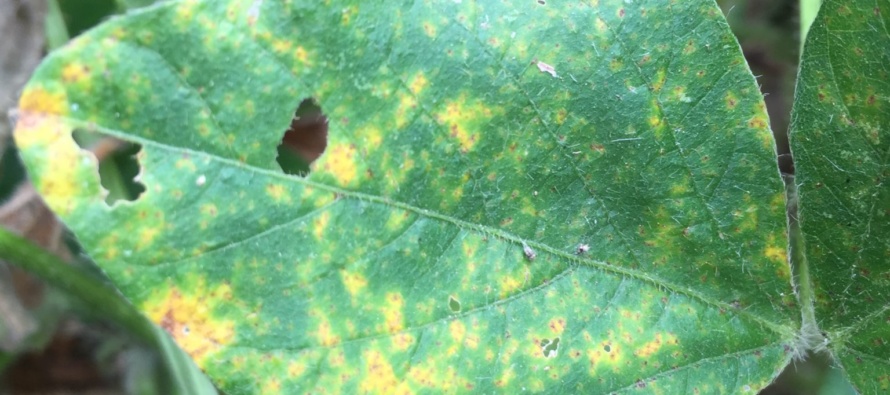Soybean Rust Update: August 5, 2017

Related Articles
- 2010 Soybean And Corn Variety Trial Data 3
- Rice Variety Trial Results For 2010, Plus Rice Research Report 0
- Evaluation of Peanut Prescription Rx Program in Mississippi 0
Latest Tweets

Soybean rust infection on a soybean leaf which can be difficult to detect without observing the pustules on the underside of the leaf.
The below information should be read carefully and fungicide application decisions should be based on soybean growth stage. Field situations vary throughout MS with soybean plants ranging from V2 (limited acreage) to R7/R8 (limited acreage). Field situations where soybean plants are at the R5.5 growth stage (50% of the developing soybean filling the pod) are considered to be outside the risk of yield losses associated with soybean rust. As with any foliar disease, the period of time required for soybean rust to increase and result in a situation that could reduce yield is generally greater than two-to-four weeks. Cut off timings for fungicide applications to protect yield in situations where soybean rust has threatened in the past have generally been around R5.5. At present, we suggest that soybean plants that have reached R5.2 (approximately 20% of the developing soybean filling the pod) will likely be safe and outside the risk of yield losses associated with soybean rust, mostly due to the environment that has occurred throughout much of the northern half of the state for the last several weeks (hot and dry).
On Thursday (August 3) soybean rust was detected in a MSU Official Variety Trial (OVT) plot at the Brown Loam Experiment Station outside of Learned, MS (south and west of Jackson, MS). Two infected leaves with an extremely small amount of rust were observed. On Friday (August 4), in a variety trial plot in Noxubee County, MS additional soybean rust was observed on soybean plants that were beyond the R5.5 growth stage. Even though a light infection was observed in the field, leaves were observed to be infected with soybean rust in all 18 of the variety trial strips in the particular field. The field had received a fungicide application 2 weeks ago with a pre-mix fungicide (strobilurin + SDHI). Pustules appeared to have been affected by the fungicide application (had died), but some sporulation was still evident. Based on those observations, and the geographic distance between the two locations it is likely that soybean rust moved through the state some time ago.
With any disease, environment tends to be the most important parameter. Soybean rust generally prefers cooler temperatures with plenty of moisture. For example, the month of June throughout much of Mississippi would have been a conducive month for soybean rust development. However, temperatures over the better part of the last three weeks and drought-like conditions in much of the state are not generally considered to be overly conducive for the increased development of soybean rust.
Soybean Rust Management
Managing soybean rust can be accomplished with a carefully timed fungicide application based on the amount of disease in the field and not the particular growth stage of the plants; however, that remains a confusing topic. Even though soybean rust was initially thought to be a disease of major concern, soybean rust infection has not resulted in the widespread yield losses that were once reported (on the order of 50-60% over a large geography).
Strobilurin fungicides are NOT effective on soybean rust if the disease is already present in a field situation. Therefore, fungicide applications should be made with a product that contains a strobilurin and a triazole, especially in the area of the state where soybean rust has been observed. Strobilurin fungicides would provide some prevention to leaf tissue that has not previously been infected.
To help guide making fungicide decisions:
-Fields having already received a fungicide application with an appropriate pre-mix product (strobilurin + triazole) somewhere between R3 and R4 that have reached R5 and beyond do NOT need a second application.
-Fields at growth stages between R3 and R4 may benefit from a fungicide application with a product that contains a triazole (as either a pre-mix fungicide or a tank mix combination) if the plants have previously been infected by the soybean rust fungus. Triazoles have activity on the rust fungus in the event that the disease is already present in a field or the application is made shortly after infection.
-Soybean fields still in vegetative growth stages should be monitored carefully. However, in general, unless a huge amount of inoculum is present in an area, vegetative soybean fields have not been observed to be infected with the soybean rust fungus in the past.




Let me tell You a sad story ! There are no comments yet, but You can be first one to comment this article.
Write a comment